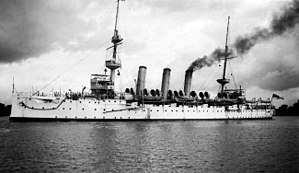HMS Hermes (1898)
 HMS Hermes at anchor, Dar es Salaam, German East Africa, before 1913
| |
| History | |
|---|---|
| Name | HMS Hermes |
| Namesake | Hermes |
| Ordered | 1897 |
| Builder | Fairfield Shipbuilding & Engineering, Govan |
| Laid down | 30 April 1897 |
| Launched | 7 April 1898 |
| Christened | Lady Kelvin |
| Completed | 5 October 1899 |
| Reclassified | Fitted to carry seaplanes in 1913 |
| Fate | Sunk by U-27, 31 October 1914 |
| General characteristics (as built) | |
| Class and type | Highflyer-class protected cruiser |
| Displacement | 5,650 long tons (5,740 t) |
| Length | |
| Beam | 54 ft (16.5 m) |
| Draught | 21 ft 6 in (6.6 m) |
| Installed power |
|
| Propulsion |
|
| Speed | 20 kn (37 km/h; 23 mph) |
| Complement | 470 |
| Armament |
|
| Armour |
|
HMS Hermes was a
Design and description

Hermes was designed to
Her main armament consisted of 11
The ship's protective deck armour ranged in thickness from 1.5 to 3 inches (38 to 76 mm). The engine hatches were protected by 5-inch (127 mm) of armour. The main guns were fitted with 3-inch gun shields and the conning tower had armour 6 inches thick.[1]
Construction and service

Hermes, named after the Greek god
She was assigned to the Channel Fleet until 1905 when she was reduced to reserve at
Work began to modify her to accommodate three seaplanes in April to evaluate the use of aircraft in support of the fleet. Her forward 6-inch gun was removed and a
Hermes was recommissioned on 7 May and loaded two unknown aircraft on 5 July, making nine flights with them before 14 July. For the trials she initially used a
The ship was paid off on 30 December,[13] but was recommissioned on 31 August 1914. Assigned to the Nore Command, she was used to ferry aircraft and stores to France.[15] It is uncertain if the flying-off platform was reinstalled.[16] On 30 October she arrived at Dunkirk with one load of seaplanes. The next morning, Hermes set out on the return journey but was recalled because a German submarine was reported in the area.[17] Despite zigzagging at a speed of 13 knots (24 km/h; 15 mph), she was torpedoed by U-27 at a range of 300 yards (270 m).[18] Hermes sank off Ruylingen Bank in the Straits of Dover with the loss of 21 of her crew.[19] Her wreck lies upside down in approximately 30 metres (98 ft) of water at coordinates 51°06′18″N 1°50′18″E / 51.10500°N 1.83833°E.[20] In January 2017, two English divers were charged with failing to declare items removed from the wreck of Hermes, in contravention of the Protection of Military Remains Act 1986.[21]
Notes
- ^ "Cwt" is the abbreviation for hundredweight, 12 cwt referring to the weight of the gun.
Footnotes
- ^ a b c d Chesneau & Kolesnik, p. 79
- ^ a b Friedman 2012, p. 336
- ^ Friedman 2011, p. 87
- ^ Friedman 2012, p. 171
- ^ Friedman 2011, pp. 87–88
- ^ Silverstone, p. 238
- ^ "Naval & Military intelligence". The Times. No. 35485. London. 8 April 1898. p. 5.
- ^ "Naval & Military Intelligence". The Times. No. 36045. London. 22 January 1900. p. 6.
- ^ "Naval & Military Intelligence". The Times. No. 36082. London. 6 March 1900. p. 11.
- ^ "Naval & Military Intelligence". The Times. No. 36090. London. 15 March 1900. p. 7.
- ^ "Naval & Military intelligence". The Times. No. 36764. London. 10 May 1902. p. 8.
- ^ Hobbs, p. 18
- ^ a b Friedman 1988, p. 28
- ^ Friedman 1988, p. 28; Hobbs, pp. 16–17; Layman, pp. 35, 37
- ^ Gardiner & Gray, p. 16
- ^ Friedman 1988, p. 30
- ^ Corbett, p. 234
- ^ Goldrick, p. 152
- ^ Roll of Honour, list of casualties
- ^ "HMS Hermes (+1914)". Wrecksite.eu. Retrieved 10 March 2014.
- ^ Whiteside, Philip (30 January 2017). "Two charged over items taken from protected WWI wreck". news.sky.com. Sky plc. Retrieved 1 February 2017.
Bibliography
- Chesneau, Roger & Kolesnik, Eugene M., eds. (1979). Conway's All the World's Fighting Ships 1860–1905. Greenwich: Conway Maritime Press. ISBN 0-8317-0302-4.
- ISBN 0-89839-256-X.
- Friedman, Norman (1988). British Carrier Aviation: The Evolution of the Ships and Their Aircraft. Annapolis, Maryland: Naval Institute Press. ISBN 0-87021-054-8.
- Friedman, Norman (2012). British Cruisers of the Victorian Era. Barnsley, South Yorkshire, UK: Seaforth. ISBN 978-1-59114-068-9.
- Friedman, Norman (2011). Naval Weapons of World War One. Barnsley, South Yorkshire, UK: Seaforth. ISBN 978-1-84832-100-7.
- Gardiner, Robert & Gray, Randal, eds. (1985). Conway's All the World's Fighting Ships 1906–1921. Annapolis, Maryland: Naval Institute Press. ISBN 0-85177-245-5.
- Goldrick, James (1984). The King's Ships Were at Sea: The War in the North Sea August 1914–February 1915. Annapolis, Maryland: Naval Institute Press. ISBN 0-87021-334-2.
- Hobbs, David (2013). British Aircraft Carriers: Design, Development and Service Histories. Barnsley, UK: Seaforth Publishing. ISBN 978-1-84832-138-0.
- Layman, R. D. (1989). Before the Aircraft Carrier: The Development of Aviation Vessels 1859–1922. Annapolis, Maryland: Naval Institute Press. ISBN 0-87021-210-9.
